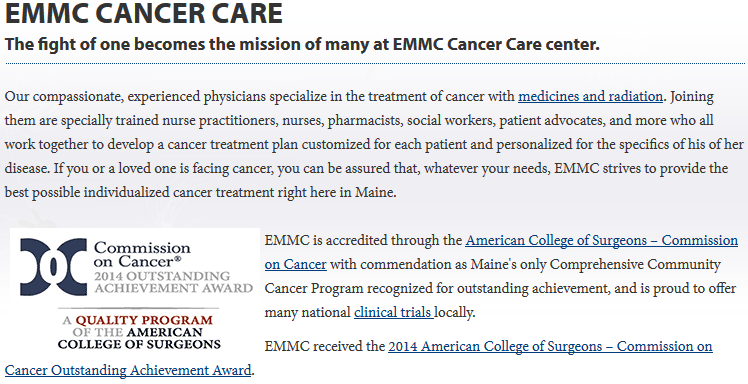An SEO Primer for Content Writers and How Eastern Maine Medical Center Ranks #1 for Cancer Care
// By Marlene Kurban //
 An ever-increasing number of consumers search the Internet for medical and health information, and within healthcare, as in many industries, there is fierce competition for search traffic. A targeted SEO strategy, combined with relevant, original content that maintains the interest of the intended audience, is key to boosting overall Web presence and capturing leads.
An ever-increasing number of consumers search the Internet for medical and health information, and within healthcare, as in many industries, there is fierce competition for search traffic. A targeted SEO strategy, combined with relevant, original content that maintains the interest of the intended audience, is key to boosting overall Web presence and capturing leads.
Both SEO and content strategy are essential for digital marketing success. Content produced in-house or outsourced must not only be compelling enough to engage the consumer, but also be discoverable by search engines. The higher your organic ranking, the better. And while Google’s algorithm for page rankings changes constantly, what hasn’t changed is the need to focus on what’s best for the visitors of your site.
Web writing is the opposite of essay writing; writers should present the conclusion first and then the supporting points. Show more than tell. Illustrate content through testimonials, graphics, and videos as appropriate. Visitors scan content, and if they don’t quickly find what they’re looking for or get bogged down in too much text, they’re apt to leave the site within a few seconds.
SEO 101
Often operating with limited budgets and resources, hospital marketing teams and content writers in particular can benefit from understanding the basics of SEO and incorporating that knowledge into every article, blog post, and infographic. Content that is thoughtfully crafted will be more likely to drive traffic to the website, improve search engine rankings, and ultimately lead to more business for the organization. Content writers who understand basic SEO terminology will find it easier to communicate with the marketing team and Web developers, as well as develop content that maximizes Web visibility.
Here are some terms that content writers should know:
Algorithm: Used by Google and other search engines, an algorithm encompasses the formulas and processes that determine which Web pages are most relevant to queries. Google’s algorithm is complex, closely guarded, and changes frequently. According to Moz, Google changes its algorithm 500-600 times a year, but may make major changes only a few times a year. Moz tracks major updates by date. For content writers, the main thing to remember is that the quality of the website is Google’s top priority. Helpful, original content that is designed for visitors and updated consistently is critical in search engine ranking.
Anchor text: Anchor text, also known as the link title, is clickable text in a hyperlink and is usually underlined or shown in blue. Anchor text should indicate where it is linking to and should never be generic (e.g., “Click here!”). As with keywords, writers should take care not to use anchor text excessively. Placing several internal links to relevant content within the website is good practice and can enhance page ranking.
The Eastern Maine Medical Center’s site provides a useful example of anchor text. At this point in time, EMMC’s website ranks first in a Google search for “cancer care in Maine.” Note the anchor text to internal pages and the outbound links:
The information in this page section is clear and concise, and ends with a call to action, “Click here to find out more about our cancer research.”
Headings: Headings, or headlines, refer to text placed in a heading tag such as H1 or H2. Generally headlines should be no more than 5 words and subheads about 8 words maximum. Keep paragraphs short (5 lines) with no more than 2 paragraphs under each subheading. Headlines, subheads, and bullets increase usability.
Inbound Links: These are links from one site to another, and a website’s ranking can improve if the sites linking to it are highly ranked. Link building from credible sites should be part of the marketing strategy and the content writer should consider opportunities where links are appropriate. Ideally, any inbound links from another authoritative site will link to the website using a descriptive phrase with relevant keywords and not just the organization’s name.
In the EMMC example above, the links to the American College of Surgeons (and its links back to EMMC) demonstrate credibility.
Keywords: Writers must keep in mind that while the words that a user is likely to enter in a search are very important to include, it is just as important not to overuse or “stuff” a website with keywords at the expense of good content. How should writers and marketers identify the best keywords to use? The first step is keyword research to discover the words that the target audience might use to search for the organization and its services. Some of this information can be gleaned from Google Analytics. It is also helpful to analyze competitors’ websites.
Keyword tools such as Google Adwords Keyword Planner and Wordtracker show high-performing keywords. Google Trends displays how often specific keywords, phrases, and terms have been queried over certain periods of time. Writers should also consider using synonyms, variants, and long tail keywords, which usually include two or more words that are less commonly used or are more specific. For example, instead of “weight loss,” a long tail keyword phrase could be “meal plans for weight loss.”
Google suggests placing keyword-rich content within the first 200 words of the page and using keywords in the HTML title tags. Other best practices include using keywords in headlines and subheads, in the URL itself, and in the title and page description.
EMMC’s first paragraph, for instance, is rich in keywords regarding cancer treatment without sounding artificial:
Our compassionate, experienced physicians specialize in the treatment of cancer with medicines and radiation. Joining them are specially trained nurse practitioners, nurses, pharmacists, social workers, patient advocates, and more who all work together to develop a cancer treatment plan customized for each patient and personalized for the specifics of his or her disease. If you or a loved one is facing cancer, you can be assured that, whatever your needs, EMMC strives to provide the best possible individualized cancer treatment right here in Maine.
Meta description: This is the brief description that appears on search engine results pages (SERP) below the Web page title. Meta description tags should include salient keywords and give enough compelling information to draw viewers to the site. Meta description tags are limited to 160 characters.
EMMC’s meta description below is a synopsis of the page and uses its targeted keywords:
A less effective meta description is illustrated in this example, which appears on page 10 of Google search results for “cancer care in Maine”:
Page Title: This is the HTML tag that appears in the top frame of most Web browsers and describes the Web page’s title and content in approximately 70 characters. Page titles should include keywords related to the organization.
Other Hints for Content Writers
As noted, website content should be geared first and foremost to the visitors of the website. What questions might visitors have, and how does the content on each page answer those questions? Each landing page should have a purpose, and should be close to a clear call to action, whether it’s to contact the organization, or download a white paper or other material.
Optimizing a website for better performance not only requires good content, but thorough analysis of the data collected in Google Analytics reports and other tools. Collaboration between writers and marketers is an ongoing process, and requires continual refinement of the online marketing strategy and website page content.
Marlene Kurban is a business development consultant and freelance writer with more than 20 years of experience in the behavioral healthcare field.




